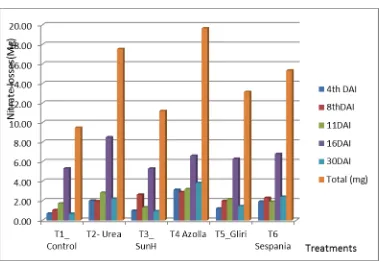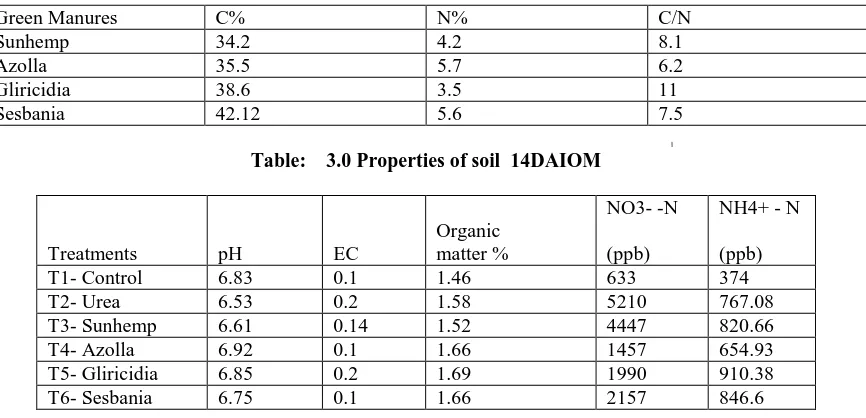Effect of Incorporating
Sesbania rostrata
, Sunhemp,
Gliricidia and Azolla on nitrate leaching in Reddish
Brown Earth Soil
Loganathan, P
Department of Bio Science, Vavuniya Campus, University of Jaffna.
Abstract- The research was carried out to minimize nitrate leachate in RBE soil by in cooperating green manures (Sesbania rostrata, Gliricidia and sunhemp) and Azolla. The soil samples for experiment was collected from non agricultural lands in Thavashikulam, Vavuniya. Experiment was carried out with RCBD with six treatments such as Control(T1), Urea (T2), Sun Hemp (T3) Azolla (T4) ) Gliricidia (T5) and Sesbania rostrata (T6), and three replicates. The results were analyzed by ANOVA for a Random Complete Block design (RCBD) to determine significance of differences (P>0.05) between the treatments. Duncun mean comparison was carried out by using SAS package. Nitrate losses were significantly (P=0.022) differ from each treatments and highest amount of loss was observed in Azolla (19.66mg) followed by Urea(17.54mg), sespania (15.34), Giliricidia ( 13.14)and sunhemp( 11.2 ). Nitrate losses were less in green manure(Sesbania, Sunhemp & Gliricidia) added soil than inorganic fertilized (urea) soil with in one month period. Green manures ( Sesbania, Sunhemp and Giliricidia) could be utilized to minimize nitrate loses in RBE soil except Azolla. Azolla could be used as bio fertilizer in wet land paddy soil as it is considered as super plant to fix atmospheric nitrogen (5-6% of nitrogen) and Nitrate loss was higher in Azolla than urea in RBE soil. The field study could be carried out to confirm the finding to implement the findings in farmers field.
Index Terms- Sesbania rostrata, Gliricidia, Sunhemp, Azolla , Nitrate leachate
I. INTRODUCTION
he Vavuniya district is located in the low country dry zone with the mean temperature of 28 ° C and annual rainfall of 1400mm. It is an agricultural area and people use surface and ground water for irrigation purpose. In Kanthapuram area, people have been engaged in cultivation of vegetable crops for more than 30 years using inorganic fertilizer. My previous research studies showed there are more than 95 % of agro wells are contaminated with Nitrate pollution due intensive use of Inorganic fertilizer Fertilizer. Nitrate contamination of ground water has become a serious problem in northern part of Sri Lanka where intensified agriculture is being practiced (Nagarajah et al., 1988). Incorporation of Green manures is the one ways to minimize nitrate leachate in soil. The objective of the study is to minimize nitrate leachate in soil by incorporating Green manures and azolla.
II. MATERIALSANDMETHODS
Soil collection
The soil samples for experiment were collected from non agricultural lands in Thavashikulam, Vavuniya and Collected samples were mixed and composite sample was used to prepare leaching column. A sub samples of collected samples were air dried and sieved through 2 mm sieve and used to determine bulk density, pH , Nitrogen, organic matter and Electrical conductivity. Electrical conductivity and pH were measured using the environmental prop (YSI model 556). Particle density was measured by Core sample method. Organic matter content was determined by Walkey and Balck method.
Establishment of Leaching Column
Poly Vinyl chloride (PVC) cylindrical tubes of 60 cm height and 10 cm diameter was packed with 1.6 gcm-3 bulk density of the soil in September 2011. At the bottom of the columns, a layer of Quartz layer and plastic net was fitted in order to avoid the movement of particles in leachate. The columns were fixed with plastic funnels which facilitated the collection of the leachate in one liter of dark bottle. Experiment was carried out with RCBD with six treatments (Control(T1), Urea (T2), Sunhemp (T3) Azolla (T4) ) Gliricidia (T5) and Sesbania rostrata (T6),) and three replicates (Figure 1.0). Each column was fertilized at rate of 0.108g total N per 78.57 X 10-4 m2 . Columns were irrigated with distilled water at 7 mm per day. The leachate was collected before irrigation and measured the volumes and analyzed the nitrate nitrogen by Brucine method (Taras, 1958). No3-N in soil was determined by sodium salicylate method and NH4 -N (Dharmakeerthi et al. 2007) was determined by indole phenol blue method. Total nitrogen of green manures were determined by kjedhal digestion method. The Nitrate nitrogen loss in leachate was analyzed by ANOVA for a Random Complete Block design (RCBD) to determine significance of differences (P>0.05) between the treatments. Duncun mean comparison was carried out using SAS package .
III. RESULT AND DISCUSSION General characteristics of soil
The soil of the experimental site was classified as Reddish Brown Earth . The chemical analysis of the soil showed that it is almost neutral with low nitrogen and organic matter content (Table 1).
ISSN 2250-3153
Nitrate leachate in different treatment
All the treatments showed similar trend in nitrate losses in leaching column (figure 2.0). Rate of leaching increased from beginning to 16DAI and then started to decline in all treatments (Figure:2.0). Highest nitrate leaching was observed during 16DAI in all treatments due to highest rate of decomposition of organic matter and increased rate of nitrate availability in soil. Urea also showed same trend due to hydrolysis of urea and consequent ammonification and nitrification.
Nitrate losses were significantly (P=0.022) differ from each treatments and highest amount of loss was observed in Azolla (19.66mg) followed by Urea(17.54mg), sesbania (15.34mg), Giliricidia (13.14mg)and sunhemp(11.2mg ) (Figure 3). Nitrate losses were less in green manure(Sesbania, Sunhemp & Gliricidia) added soil than inorganic fertilized soil with in one month period. Low NH4+-N (Table 3.0) in azolla than other green manures could be the reason for higher nitrate losses in Azolla than other green manures. And also azolla could be decomposed faster than other green manures as C/N ratio (6.2) of azolla was lower than other green manures ( Table 2.0). Hence azolla could be utilized in wet land paddy cultivation as bio fertilizer as there is a hard pan to prevent leachate.
Properties of soil after in cooperation of Green manure Application of green manure significantly increased the soil organic matter content (OM) (P <0.001), NO3- N (P <0.003) and NH4-N (p <0.009) compare to control in 14 days after incorporation of organic matter (14DAIOM). Accordingly, OM content ranged from 1.46 – 1.69, No3 –N ranged from 633 – 5210ppb, and NH4-N ranged from 374- 910ppb (Table 3.0). Higher amount of NH4+-N was observed in all green manure added soil except azolla than inorganic fertilized (urea)soil and No3 –N was less in green manure added soil than urea. Hence application of green manure except azolla decrease soil nitrogen losses by increase soil organic matter content and NH4-N (Sangakkara 2005).
Total mineral nitrogen (No3- N + NH4-N) in all treatments were significantly higher (p<0.0001) than control and more or less same as organic and inorganic fertilized soil except sesbania (Table 4.0) after one month of irrigation/ 45 days after in cooperation of grenn manure. Highest mineral nitrogen was observed in Sesbania than other green manures and urea .
Hence green manures (Sesbania, gliricidia and sunhemp) could be used as organic fertilizer to improve soil fertility (Alain Clement et al. 1998) and reduce nitrate pollution in ground water.
IV. CONCLUSION
Green manures ( Sesbania rostrata, Sunhemp and Giliricidia) could be utilized to minimize nitrate loses in RBE soil except Azolla. Azolla could be used as bio fertilizer in wet land paddy soil as it is considered as super plant to fix atmospheric nitrogen (5-6% of nitrogen) and Nitrate loss was higher in Azolla than urea in RBE soil. The field study could be carried out to confirm the finding to implement the findings in farmers field.
ACKNOWLEDGMENT
Authors wish to acknowledge the financial assistance given by Vavuniya Campus through Research Grant 2011.
REFERENCES
[1] Alain Clement, Jagdish K.L, Francois P.C.(1998). Nitrogen Dynamic of various Green manure species and relationship to low land rice production. Journal of American Society of Agronomy. 90: 149-155.
[2] Dharmakeerthi, R.S, S.P.Indrani and D.Kumaragamaghe 2007. Manual of soil sampling and analysis. Soil science society of Sri Lanka.
[3] Sangakakra, U.R., Pietsch, G., Gollner,M and Freyer. (2005). Effect of incorporating rice straw or leaves of gliricidia on the productivity of Mungbean (Vigna radiata) and on soil properties. http://www.boku.ac.at/biofix/publikationen/ISOFAR2005.
[4] Taras, M.J. (1958). Nitrogen. In: chemical analysis. Vol. VIII. Calorimetric determination of non-metals, Ed. D. F. Bolts, 75-160. New York: Inter Science publishers Inc.
AUTHORS
First Author – Ms.P.Loganathan, Senior Lecturer (B.Sc in
Table1: Important characteristics of soil at experimental site
Soil property Content
Texture Sandy Clay loam
Sand (%) 64.4
Silt (%) 10
Clay (%) 25.6
Bulk density (gcm-3) 1.60
EC (ds/m) 0.2
pH 6.82
Total N (%) 0.102
Organic matter (%) 0.84
ISSN 2250-3153
[image:4.612.117.498.349.611.2]Table 2.0 C/N of Green Manures
Green Manures C% N% C/N
Sunhemp 34.2 4.2 8.1
Azolla 35.5 5.7 6.2
Gliricidia 38.6 3.5 11
[image:5.612.93.526.75.284.2]Sesbania 42.12 5.6 7.5
Table: 3.0 Properties of soil 14DAIOM
Treatments pH EC
Organic matter %
NO3- -N
(ppb)
NH4+ - N
(ppb)
T1- Control 6.83 0.1 1.46 633 374
T2- Urea 6.53 0.2 1.58 5210 767.08
T3- Sunhemp 6.61 0.14 1.52 4447 820.66
T4- Azolla 6.92 0.1 1.66 1457 654.93
T5- Gliricidia 6.85 0.2 1.69 1990 910.38
T6- Sesbania 6.75 0.1 1.66 2157 846.6
Table 4.0 Comparison of the mineral nitrogen in inorganic fertilized soil and organic fertilized soil 45 Days After In cooperation of Organic Matter (45DAIOM)
Means with the same letters are not significantly different at p<0.0001
Treatments Total Mineral Nitrogen(No3 –N + NH4-N)
T1- Control 1286.4 c
T2- Urea 1959.9 b
T3- Sunhemp 1911.3 b
T4- Azolla 1885.9 b
T5- Gliricidia 1809.7 b

